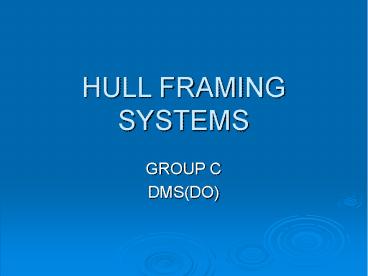HULL FRAMING SYSTEMS PowerPoint PPT Presentation
Title: HULL FRAMING SYSTEMS
1
HULL FRAMING SYSTEMS
- GROUP C
- DMS(DO)
2
QUESTION
- Describe and compare transverse and longitudinal
framing systems and explain the need for
combination framing system.
3
FRAMING SYSTEMS
- There are three possible ways to fit the
secondary supporting members
- Transverse Framing System
- Longitudinal Framing System
- Combined or Mixed Framing System
4
TRANSVERSE FRAMING SYSTEM
- The hold frames are fitted transversely
- Longitudinal deck girders support the transverse
deck beams - Longitudinal strength in a transversely framed
ship is provided by - The centre girder, the shell plating and inner
bottom plating - By the deck plating outboard of hatch and
machinery casing openings - By a number of large, widely spaced longitudinal
members e.g. longitudinal deck girders
5
TRANSVERSE FRAMED OIL TANKER
6
LONGITUDINAL FRAMING SYSTEM
- All secondary supporting members are fitted the
longitudinal direction and are known as
longitudinals - The system consists of many small, closely spaced
longitudinals supporting the plating directly and
being supported in turn by a few largely spaced
longitudinals - It is in tankers that this system in its purest
form is employed - They also contribute to the longitudinal strength
of the ship, making the longitudinal framing
system more structurally efficient than the
transverse system
7
LONGITUDINALLY FRAMED OIL TANKER
8
COMPARISON
- No contribution to the ships resistance to
longitudinal bending. - Not optimal from the standpoint of structural
efficiency, i.e. achieving the required strength
for the least weight.
- More resistant to buckling between longitudinal
stiffeners when subjected to compressive stresses
while bending in seaway. - Superior structural efficiency because most of
the plating stiffeners are in the fore and aft
direction.
- The intrusion of deep webs into prime cargo
spaces for ships carrying packaged cargo is a
disadvantage of longitudinal framing system. - As the hull narrows toward bow and stem, the
girth necessary reduces. - Difficulties in construction arise when the
longitudinal frames converge so closely. - For this reason, transverse framing is usually
resorted to at the bow and stem of longitudinally
framed ships.
9
COMBINED FRAMING SYSTEM
- A combination of both transverse and longitudinal
framing is adopted in the same cross section of
the ship. - Longitudinal framing is used in the bottom and
decks. - This has the advantage of extra longitudinal
strength and resistance to compressive plate
buckling. - Transverse framing is used in the sides.
- This precludes the need for deep webs that might
inhibit efficient cargo stowage.
10
COMPOSITELY FRAMED OIL TANKER
11
REFERENCES
- Ship Powering and Construction Notes
- Naval Architecture Lectures on the web
- http//web.nps.navy.mil/me/tsse/NavArchWeb/lectur
es.htm/

